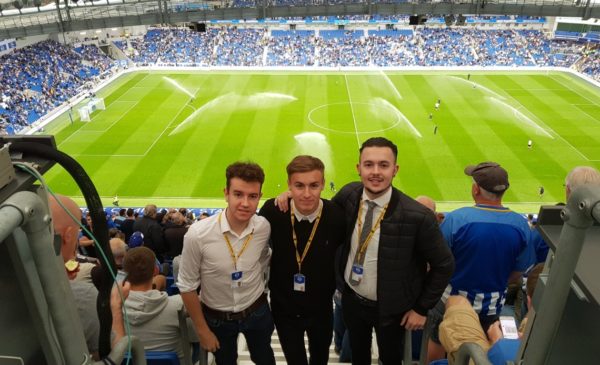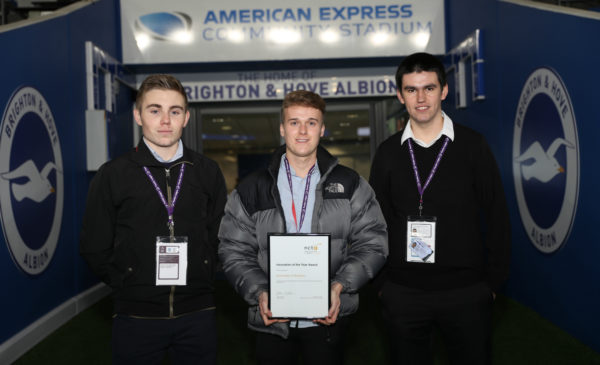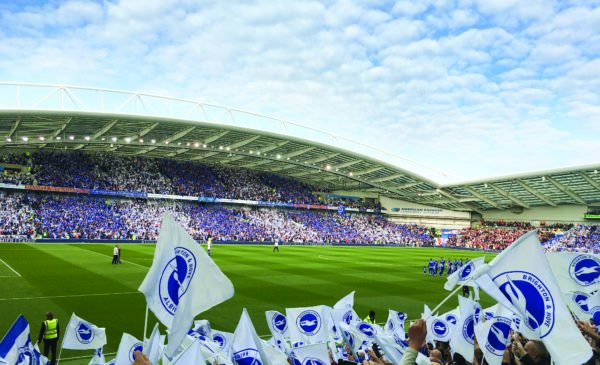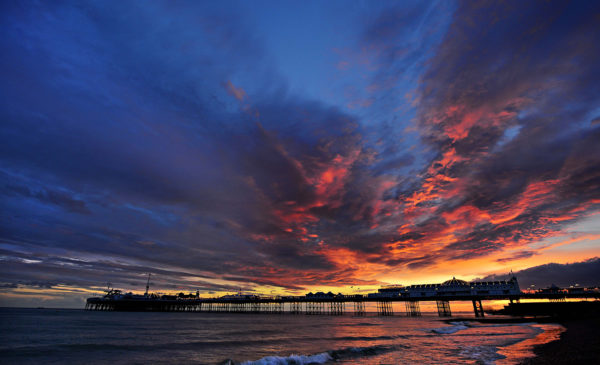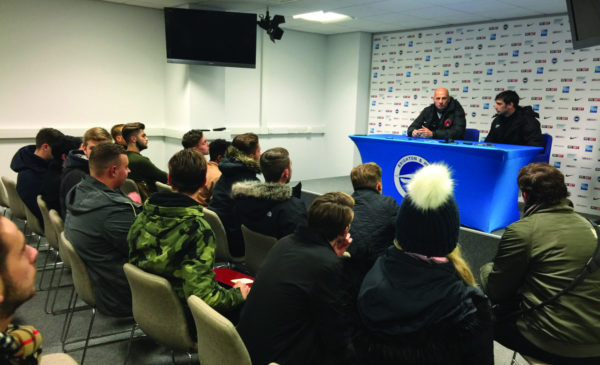Words by Ciaran Coyle
Embed from Getty ImagesFebruary 4th 2017. Arsenal comprehensively beaten by Chelsea at Stamford Bridge, dealing a huge blow to their title aspirations in the process. The final whistle was met with unrest from those in the away end, with some looking to vent their frustration at manager, Arsène Wenger, through the medium of pre-made signs and banners displaying a clear message, ‘ENOUGH IS ENOUGH, TIME TO GO!’ [1]
Outside the ground, YouTube channel ‘Arsenal Fan TV’ had their cameras primed and ready to capture the fan opinion from those in attendance, with the majority of those interviewed unsurprisingly scathing of another lacklustre performance from their side. The following day, former Manchester United defender and Sky Sports pundit, Gary Neville, voiced his opinion on Arsenal fans being filmed “slating and slanging” the Arsenal boss, before labelling the scenes outside Stamford Bridge as “embarrassing.” [2]
Whilst Neville later clarified his comments in a video with representatives of Arsenal Fan TV saying that he “doesn’t disagree with the idea of Fan TV”[3], this was perhaps the first indication of the fractured relationship between the ‘mainstream sports media’ and independent fan media platforms.
Just over a year ago, Neville launched his own YouTube channel called ‘The Overlap’,[4] which plays host to ‘The Overlap Fan Debate’, a show that takes the form of an open panel discussion of the most topical issues regarding the Premier League. The series is presented by ‘celebrity influencer’ and former sports presenter for LADbible and SPORTbible, Josh Denzel [5], and features an audience of representatives from fan channels and podcasts from all twenty clubs, who get to ask questions and debate the issues with the chosen pundits. That particular series is the highest performing in terms viewers on the channel, with the show amassing just under 12 million views over five videos. [6]
This business venture gives an indication of how attitudes towards independent football fan content creators and their placing in the minds of figures within the ‘mainstream sports media’ are changing, with people beginning to understand and attempting to utilise the gravitas these creators carry for the modern football fan. The Overlap is just one of a host of digital media platforms that have been created by former footballers, with Neville’s former Manchester United teammate Rio Ferdinand also incorporating two YouTube personalities as co-presenters on his YouTube channel, ‘Rio Ferdinand Presents FIVE’, in the form of Joel Beya, Presenter for the Cheeky Sport YouTube Channel and Stephen Howson, member of Manchester United fans channel, Stretford Paddock. [7] Embed from Getty Images
Read | Manchester United: The 26 Barren Years
Presenter and YouTuber, Zac Djellab, started out as a member of ‘The Football Daily’ YouTube channel and has now landed presenting roles for Chelsea TV, the club’s official television channel, as well as Sky Sports on productions like ‘Saturday Social’ and ‘Watchalongs’ of some of the Premier League games that took place during the initial Coronavirus Lockdown where fans were not permitted to be in stadiums. He explains that these ‘mainstream’ figures are enjoying success on these alternative digital platforms because of their willingness to learn and adapt.
“We are not only seeing the digital side coming over to the mainstream and doing really well but we are also seeing these mainstream guys coming over to the digital side and doing well.
“The reason they do well is because they are not entering this field saying ‘I’m the best, I’m from TV, YouTube is below me but I will do it anyway because it’s easy money’, they are coming in and studying it and they’re seeing what’s working on YouTube, what they can do on YouTube and adapting to it and because they’re already well known from TV, they’re absolutely killing it.” [8]
As Djellab alluded to, the attempts made by individuals once housed exclusively by the likes of the BBC, Sky Sports and BT Sport to expand into the other digital means of content creation seem to show a greater understanding of the power and reach that can be achieved with engaging with social media platforms, but with the corporate interest involved in the creation of these channels, there is a still a question over whether these trends are showing an increased respect for the platforms or whether it’s an indication that there is an understanding of the financial incentives that can be gained by expanding their content into new mediums.
‘The Overlap’, for example, is part of ‘The SkyBet Content Hub’ which has produced a number of YouTube shows involving Sky employees including ‘Off The Hook with Jimmy Bullard’ and ‘Micah Richards and Roy Keane’s Road To Wembley’. [9] The main ‘characters’ within these videos, whilst showing an understanding and acceptance of the validity of these platforms by agreeing to take part in these shows, are partaking in productions that are produced by the media corporation they’re working for. This example could be perceived as an attempt by a ‘mainstream sports media company’ to explore different avenues of content production in order to reach new audiences rather than simply an ex-pro wanting to start a YouTube channel.
The above example gives us a look into how companies are seeking to create digital content which exists separately from their normal programming. Recently, there has also been a trend regarding the way media outlets are looking to present their content, with some opting to make their content available to consume on social media platforms like Twitter and YouTube.
Embed from Getty ImagesRead | The Revolution Will Be Digitised: The New-Age Media Changing The Face Of Football Consumption
One prominent example of this is the practices of talkSPORT, who decided to pay a lot more attention to their YouTube channel by creating daily content using clips from their live broadcasts. Recently, they have also started to livestream some of their most well-listened-to shows on their channel such as ‘The White and Jordan Show’. [10] Tom Scholes, Social Media Producer at the station, when asked about the motivations behind this calculated decision, emphasised the importance of tapping into “The next generation of listeners.”[11]
Scholes said: “One thing I can always say about the mainstream media is that they know how to adapt. Newspapers have been dying for 15 years but they are still finding ways to keep going. When you understand that the race is run on one thing you move onto another thing.
“If it means that YouTubers and fan channels overtake some of the radio and television shows in terms of views, it just shows where the medium is going; it shows where the audiences are looking for content. They’re not tuning into radio anymore they’re going onto YouTube which is why we’ve adapted to live streams on YouTube and really pushing an increased amount of content on there because yeah Twitter is cool but YouTube is there, Tik Tok is there, that’s where the next generation of listeners are.
“I get told by people on a daily basis where I work that they watch the YouTube videos and aren’t aware of the radio show.”
The latest listening figures, as of December 2021, show that the sports radio station has an average weekly listenership of approximately 2.8 million people, which is the lowest it’s been since June 2017 and they have seen a drop in their market share within UK radio which has declined by 0.3 percent since March 2020. These listening figures are based on the premise that a listener is ‘counted as an adult aged 15+ who listens for at least five minutes’ which perhaps doesn’t encapsulate the market the station controllers are attempting to tap into with the move to digitise their content. These figures, however, may not represent a clear picture of a station with a declining listener base as talkSPORT listening figures have been seen to rise when the national interest in football is high like during major tournaments. [12]
Academic research into this topic suggests those at the helm of various radio stations have always been looking for ways to adapt to the ‘digital age’. A study from the Radio Advertising Bureau and The Internet Advertising Bureau carried out in 2006 found that whilst there was still a consistent level of people with the desire to listen to radio broadcasts despite digital platforms starting to take an increasing share of the radio listenership, potential listeners were already moving to the internet and ‘expecting to find a new environment for radio genres.’ [13] This gives a big indication that adapting to new developments and changing media landscapes has always been the name of the game for these companies and that this change is not necessarily correlated with the success independent online football content creators have had in building their platforms.
The technique talkSPORT have implemented by livestreaming their radio broadcasts on YouTube as well as uploading clips from the show has been replicated by a multitude of other mainstream sports broadcasters. The ‘Sky Sports News YouTube channel’ plays host to videos which are made up of footage from the television broadcast showing how they covered a breaking story. [14] Along with other established sports media outlets like BT Sport and ITV Sport, they have also been seen to upload clips of pundits giving their opinions before, during and after a football match has finished. [15]
Whilst there has been an evident shift in how mainstream outlets understand the power of the platforms that can be built by football fans on YouTube among other social media sites, there has also been an increase in people who have built their own online fan platforms being able to break into mainstream sports media productions. One of the highest profile cases of this is Rory Jennings.
Jennings made his name on YouTube as a presenter on football fan channel, ‘Chelsea Fans Channel’ before becoming a household name on ‘The Kick Off’, a football debate show hosted on the streaming platform Twitch which sees clips of the show uploaded to its YouTube channel. [16] Since helping to build multiple football fan platforms on YouTube he has made multiple appearances on talkSPORT and talkSPORT 2, with the Chelsea fan featuring as a panellist on drive time show ‘The Boot Room’ [17] as well as evening football discussion show ‘The Eye Test’. [18]Producer Scholes talks about his experience working with Rory and the appeal of bringing him into the fold at the radio station.
Scholes said: “When Rory arrived at talkSPORT, some people had never heard of him, most people thought he was just some YouTuber but I remember seeing him on The Kick Off and other channels and remember thinking, no he’s got something in him. Just because he isn’t an ex footballer or a traditional presenter or pundit doesn’t mean he can’t do a job.
“I remember when he was on ‘The Boot Room’; he took Steve Bruce to pieces. Rory had the fans point of view because he didn’t have any relationships with the person he was talking about. He saw it in the same way that you and I would see it and I think a lot of people responded to it because they thought, we don’t know who this guy is but he says it how he thinks and he doesn’t have the issue of hiding from giving controversial opinions because of a mate he has in football.”
When a clip from the show was posted on the talkSPORT Twitter page in October last year showing Rory voicing his opinion on Newcastle’s position in the Premier League relegation battle, there were mixed responses in the ‘replies section’ underneath the tweet, with some users siding with the YouTuber’s opinion whilst others vented their frustrations by questioning why talkSPORT had brought him onto the platform. [19] Comments like “well, Rory Jennings has spoken, who’s Rory Jennings” [20] and “How on earth did this clown get on talkSPORT?” [21] were a constant theme underneath the post.
These comments seem to give an indication of the sort of content that consumers expect from mainstream sports media companies, with people targeting their anger at the lack of validity a YouTube content creator’s opinion carries compared to that of an ex-professional. With the average age of a talkSPORT listener being 37 years old [22] and YouTube being created in 2005, [23] these comments may be more of a reflection of an audience who have grown up and been used to listening to ex-professional footballers that they have knowledge of playing the role of pundit which leads to a rejection of people like Rory playing that role as he doesn’t have the necessary experience in the game and in their minds, should be kept separate from being a panellist alongside other ex-pros.
Scholes also believes the reasons behind some of the ‘hate’ directed towards content creators who are seen on ‘mainstream sports media platforms’ like talkSPORT is “a generational thing.”
Scholes said: “I suppose the way I look at it is it’s like a new footballer that arrives onto the scene who is doing things that are different from what has been done before, people are taken aback by it but not in a good way, they look at it from the perspective of ‘this isn’t the way it’s meant to be done, you haven’t done what I’ve done, you haven’t done the traditional route’.
“Just Because they haven’t gone the traditional route by doing the runner jobs, getting the tea etc, that doesn’t mean they haven’t worked hard to get where they are and that’s the benefit of being our age is that people understand this because they follow their eyes.”
He also talked about the appeal of working with fans that have built big followings for themselves like Rory and how the uncertainty around attempting to bring mainstream and independent mediums together has faded away.
Embed from Getty ImagesRead | Spencer Owen and Hashtag United: The revolution will not be televised
Scholes said: “From a social media point of view, because these creators already have a fan base behind them, it’s a dream as they can share things and it spreads more because the people that follow them will also follow what they do.
“When the first person made that transition, I’m sure there was a bit of ‘I’m not sure how this is going to work’ but there have been enough case studies of this paying off for it to carry on and to work. I think we have upped our game by bringing people in from other mediums and it’s worked very well so far.”
This is not the only recent instance of consumers voicing their frustrations at the attempt to bring online content creators onto a mainstream sports media platform. MUTV, Manchester United’s official television channel decided to host a debate show called ‘The Debate’, in which they brought in representatives from West Ham, Arsenal and Tottenham Hotspur fan channels with a view of discussing the Premier League top four race. [24]
The idea received a lot of backlash from fans of ‘The Red Devils’ with one reply under a promotional post tweeted by presenter Stewart Gardner reading ‘what a sad day for football journalism’. [25] Mark Goldbridge, founder and presenter of Manchester United fan channel ‘The United Stand’ replied to the tweet seemingly agreeing with the idea that the television station shouldn’t be mixing with online fan content creators as he tweeted “Actually agree. The club shouldn’t be linking up with fan channels.” [26] When questioned by another Twitter user in the ‘replies section’ of the original tweet, Goldbridge explained his opinion by tweeting: “Because they clearly have no idea about the people they are asking on & what they are involved in. But more importantly it’s a club outlet. They should not be engaging in opinionated content.” [27]
Some would make the observation that, as Goldbridge alludes to above, club media channels like MUTV tend to have a target audience of football fans of a particular club who have paid a subscription fee for content that addresses the needs of its target audience which in this case is Manchester United fans. At the time of the show being broadcast, United had just been knocked out of this season’s Champions League at the Round of 16 stages so the feeling amongst the fans was not a jovial one. This puts into question whether the negative reaction is a result of the inclusion of these online content creators or whether it’s more a reaction to the subject matter behind the content that’s been offered up.
YouTuber and Presenter Djellab, when asked about his thoughts on the negative response to MUTV’s attempt to incorporate content creators onto their platform, felt that criticism of those involved in the production of the show was “harsh.”
Djellab said: “They have got the right idea, they’re trying to become digital and have seen what works on YouTube but they have not executed it right. What I think is a bit harsh is that these people are trying their best with being told ‘you have to make a big video, get these big personalities in, what can you do with this’ and they haven’t thought about the backlash.”
Evidently, there have been mixed responses when online football content creators have made appearances on mainstream sports media platforms, but invitations onto TV and radio shows are not the only way companies have attempted to harness the audiences these content creators have built.
In March 2017, Multi-Channel Network ‘Diagonal View’, which helped to produce the football YouTube channel ‘Football Daily’, was bought by Sky. [28] The football channel produces daily football content including ‘Top 10 lists’ as well as debate shows where they discuss the latest transfer news and talking points from the world of football such as ‘Transfer Talk’ and ‘Sunday Vibes’. Djellab, who has been a presenter and constant feature on the channel since its inception in 2011, talks about the reasons why he felt Sky chose to invest in their channel and how his experience of working for the channel changed after the purchase.
Djellab said: “Sky saw that Football Daily had an audience that they didn’t have at the time and that’s what they use us for, to reach these people. You will probably see more companies doing this. For example you can see this in other sports as well with big American sports networks buying NFL and fantasy football channels. I think these big companies realise that they don’t know how to tap into these audiences and so they need to find the right people that can do.
“It’s a very different setting in terms of before and after being purchased by a company like sky. Beforehand it’s just us guys in a room from eight till eight and smashing out these videos and we can say what we want. When a bigger company comes in there are a lot more rules you have to follow, which is a benefit, and gives you the access to going onto mainstream media and TV.”
Djellab has managed to land roles within the mainstream sports media as a presenter for Chelsea TV and Sky Sports and says the response he has received on social media has been “pretty positive” despite some of the stigma surrounding YouTubers making the transition onto mainstream sports media platforms.
Djellab said: “I remember reading things like ‘OMG it’s crazy that Zac from Football Daily is on Chelsea TV’ and it is crazy to be presenting for the team that I have supported since I was a kid. When I did a TV show with Smithy (Adam Smith) and two premier league footballers on Sky, there were a lot of positive responses but there were also negative responses from people who have never seen a YouTube video in their lives who were asking what I was doing there.
“There have definitely been negative comments but I think in whatever you do especially when it has such a wide audience and with such a variety of different people watching, you’re never going to please everyone.”
Djellab’s determination to get access to opportunities within the mainstream sports media raises an interesting point about the prestige at which working for and representing these companies still holds for content creators, who may have built online platforms with audiences that exceed the likes of Sky Sports and talkSPORT . If the ultimate desire for some of those who create online independent football content through YouTube channels, podcasts or their own blog pages, is still to land roles at the BBC or BT Sport for example, this would suggest that despite the rise and success of these independent platforms, established sports media outlets are still viewed as the career pinnacle for these content creators.
Within mainstream sports print media however, there have been fewer examples of online independent football content creators like the ones mentioned above being able to break into the industry. Like television and radio stations, newspapers have opted to diversify their content production by branching out to digital media platforms. The Guardian [29] and The Times [30] both produce weekly football podcasts which are free to listen to on platforms like Spotify and Apple Podcasts which are centred on discussing the latest news from the world of football. Whilst these examples may not be linked with the success of independent online football content creation, it does provide an indication of how the role of a sports journalist has been affected by the development and success of these digital platforms.
Mike Keegan, Sports News Correspondent at the Daily Mail and MailOnline believes the role of a sports journalist has changed in light of the ‘digital age’ especially when it comes to creating an ‘online presence’. [31]
Keegan said: “You have to be open to social media and embrace it. Gone are the days where you could just be a journalist and no one would know your face, you’ve got to be ready to put yourself out there, go on radio or TV and standby your work and make sure that all the different platforms we need content for have that content.”
As well as TV and radio broadcasts, there have also been instances where Journalists have made appearances on independent online football media platforms including podcasts and fan channels, with Journalists helping to inform the viewers of any insider knowledge they have on breaking news stories surrounding the club the channel is covering. Following the announcement of the ‘European Super League’ in October last year, Henry Winter, Chief Football Writer for The Times made appearances on a multitude of different fan channels including Liverpool fan channel, ‘The Redmen TV’ [32] and Arsenal fan channel ‘Highbury Squad’. [33]
However, whist the willingness displayed by some Sports Journalists to make appearances on YouTube channels and podcasts in order to pass on their insider knowledge to viewers would suggest there can be a non-competitive relationship between content creators and journalists, not everyone is happy with providing the opportunity for content creators to play the role of sports reporter.
When Flex, presenter for Manchester United fan channel The United Stand, was not only invited to a pre-match press conference for their Europa League group stage game against Astana, but was allowed to put a question to then United boss Ole Gunnar Solskjaer, it prompted a negative reaction from some journalists, who were questioning the journalistic integrity of the question asked. Samuel Luckhurst, Chief Manchester United correspondent for the Manchester Evening News tweeted: “Odd moment as Solskjaer is asked a question referring to United as ‘we’” [34] whilst Premier League reporter, Vaishali Bhardwaj, when asked about whether representatives from fan channels should be allowed in press conferences on talkSPORT said: “I do wonder about the quality of questions we might get.” [35]
Embed from Getty ImagesRead | Ole Gunnar Solskjaer: Super-Sub, Goal Machine and Model Professional
Keegan, when asked about what he thought of the reaction from journalists in this scenario, emphasised the importance of adhering to journalistic practices such as remaining impartial in order to be respected as a journalist and felt that he could understand the potential negative reaction journalists could have to questions asked in that way.
Keegan said: “I could see why if you were a journalist, going there every week trying to be impartial and holding people to account and then someone from a fan channel starts referring to them as “we” and the questions aren’t the questions you would expect form a press conference then I could see how it could cause offence.
“But I don’t want to generalise because there are good fan channels out there. As a journalist it goes back to bringing stuff to life and telling people things they don’t know and a big part of that is being impartial. It’s key. If you want to be a journalist and taken seriously you can’t have agendas.”
The football writer went on to give his own solution on how both journalists and fan channels could be incorporated into press conferences successfully saying “I don’t see a world where the two can’t exist.”
Keegan said: Maybe the solution is that the fan channel representatives get their chance to ask whatever questions they want and if the content that comes out of it is great, why don’t the newspapers do what the aggregators do and take it off them as long as they give them credit for it.”
Whilst there are some Journalists like Keegan who don’t have a problem with fan channels being granted the same access to players and managers as they have, academic voices such as Ari Heinonen suggest that journalists will look to ‘gate-keep’ the exclusivity of the profession as he believes “Journalism exists for and by its audience.” He suggests that if journalists relinquish the exclusive access they have to sources of news, there will be less reason for football fans to flock to their articles as they will be able to get the same level of insight on other platforms [36]. This will mean that they relinquish the power and gravitas they once had in the eyes of their readers. Applying this insight to the previous example, it could be perceived that the reaction of journalists, Luckhurst and Bhardwaj, was a result of their awareness the threat allowing fan channel representatives like Flex poses to the dominant position their profession holds in the production of football news.
There is some evidence to suggest however, that this ‘dominant position’ journalists hold over gaining access to club managers and players alike is outdated. Clubs like Liverpool and Celtic have already been seen allowing fan bloggers to ask questions of their respective players and managers in press conferences, with the likes of ‘The Redmen TV’ having the rights to not only attend, but post full, un-edited versions of Jurgen Klopp’s press conferences on their platform. [37] There is also data to suggest the success of these independent online fan platforms is directly detrimental to the number of people who engage with newspaper articles covering the club they support.
‘The Celtic Star’, an online Celtic fan blog website which also creates content on YouTube, released a poll on their Twitter page which revealed that 79 percent of Celtic fans who responded said they engage more with ‘fan media platforms’ than mainstream media when it comes to Celtic. [38] Whilst this is a small sample size and isn’t representative of every football fan who engages with both online fan media and mainstream sports media, it gives an indication of the potential threat the popularity of these platforms pose to the readership of the newspapers these journalists write for.
Mike Keegan, who himself has made appearances on ‘fan media platforms’ including Oldham Athletic fan podcast ‘The Boundary Park Alert System’[39], says he doesn’t see the rise of independent online football platforms as a threat to his profession as they perform different roles for football fans.
Keegan said: “I think there is an audience there for objective journalism with no agenda and if there isn’t then it’s a sad world that we live in. There is a market for objective reporting that holds people to account and I’m not sure you get that from the fan channels and I don’t think they would try and claim that’s what they’re they’re for.
“These days it’s very rare that you would subscribe to one channel, you would have Sky, BT Sport, Amazon Prime and Netflix for example because we all have different appetites so I don’t see why fan channels can’t exist and I don’t see it as a threat. Others might, but it’s not a threat to me.”
He goes onto to say that whilst some look towards statistics showing the decline in interaction with print publications, journalists still perform an important role in providing objective news to the public regardless on which platform they consume it on.
Keegan said: “A lot of people pay attention to print circulation figures but the fact is, at no point in the history of journalism are more people reading our work and that can’t be a bad thing and hopefully that continues going forward and if people read it on a phone or on a laptop or wherever we will be in 20 years, people still need to provide that information so I actually think it’s an exciting time for journalism and I would hope we are getting closer to the answer of how we continue to fund this.”
Some publications have opted to implement changes to their business models with the likes of The Times [40] and The Telegraph [41] deciding to put their online articles behind a paywall in the form of a subscription-based system whilst The Guardian have recently begun asking readers to make a donation to the publication, with a statement on their website claiming every contribution “powers our journalism and sustains our future.” [42] Whilst this may simply represent a strategy implemented to deal with the fall in revenue generated from print media, which has been in steady decline since 2005 [43], it could represent a change in attitudes towards people’s desire to consume journalism in the same way that they did previously which has led to a decline in readership.
In terms of the mainstream sports media, it could be argued that their engagement and gravitas in the eyes of the potential consumer is what has made the public considered the mediums ‘mainstream’ in the first place. With publications like The Guardian having to ask for donations and sports television and radio stations having to branch out by moving their content production onto online platforms like YouTube in order to make an attempt to tap into new audiences, it could be put into question whether the idea that those three mediums are still ‘mainstream’ as stand-alone institutions is outdated in itself. In this case, the rise in independent online football platforms actually don’t pose a threat in the current media landscape as there is nothing left to threaten.
However, despite the potential loss of viewer or readership within certain aspects of mainstream football media production, something which content creators do not yet have the financial capacity to threaten is the rights to broadcast the beautiful game. With the latest Premier League TV Broadcast rights deal worth a fee in the region of £5.1 billion [44], this is something which the owners of fan channels or podcasts cannot compete with and will not be able to get access to in the same way that they would be able to get access to press conferences for example. This brings us back to the idea that the independent and mainstream football media are able to exist together as they play different roles for consumers which means that there is no reason for the bosses of Sky or BT to be threatened by football content creators just yet.
Yet, some would argue that the willingness to bring these content creators over to mainstream platforms could be seen as a way of controlling the ‘opposition’ as the threat the increasing influence football content creators have over today’s sports media consumers can be nullified if broadcasters use their influence for their own gain in terms of getting them to share their content on social media platforms and generate more traffic. In this way, the willingness of some aspects of mainstream football media to embrace the success of YouTube fan channels and podcasts among other new forms of football media output may have saved them from further damage whilst helping to keep them ‘relevant’ to the new generation of viewers and listeners.
Whatever your opinion on independent online football media platforms, as talkSPORT Social Media Producer, Tom Scholes put it to me, “You can try your best to not look at new media if you want but they are coming up with new ways to create eye-catching content that makes it impossible for you to ignore them.”
By Ciaran Coyle @CiaranJCoyle
1. McNulty, P. Chelsea 3-1 Arsenal Match Report. 2017 [cited 2022 May 3rd]; Available from: https://www.bbc.co.uk/sport/football/38779302.
2. Street, S. ‘EMBARRASSING’ Gary Neville lays into Arsenal Fan TV and says Arsene Wenger ‘doesn’t deserve’ the treatment he is getting from Gunners fans. 2017 [cited 2022 May 3rd]; Available from: https://www.thesun.co.uk/sport/football/2791497/gary-neville-lays-into-arsenal-fan-tv-and-says-arsene-wenger-doesnt-deserve-the-treatment-he-is-getting-from-gunners-fans/.
3. Neville, G., SHOWDOWN: Garry Neville meets ArsenalFanTV (Ft DT, Troopz, Claude and Moh), in Arsenal Fan TV, R. Lyle, Editor. 2017: YouTube.
4. Neville, G. The Overlap YouTube Channel. 2021 [cited 2022 May 3rd]; Available from: https://www.youtube.com/c/TheOverlap.
5. Matchmaker, I. Josh Denzel. 2022 [cited 2022 May 3rd]; Available from: https://influencermatchmaker.co.uk/celebrity-influencers/josh-denzel.
6. Neville, G. The Overlap YouTube Channel Videos. 2021 [cited 2022 May 3rd]; Available from: https://www.youtube.com/c/TheOverlap/videos.
7. Ferdinand, R. Rio Ferdinand Presents FIVE. 2009; Available from: https://www.youtube.com/c/5magazine.
8. Djellab, Z., Zac Djellab Interview, C. Coyle, Editor. 2022.
9. Bet, S. Sky Bet Content Hub. 2022 [cited 2022 March 4th]; Available from: https://m.skybet.com/lp/content-hub.
10. talkSPORT. Can You Sack Your Way To Success? Simon Jordan and Jim White look at Watford’s model! 2021 [cited 2022 May 4th]; Available from: https://www.youtube.com/watch?v=r1fyAUopY1Y&list=PLFVMnSsi_04LJwabEBbKQztYJyEvsi2C8&ab_channel=talkSPORT.
11. Scholes, T., Interview with Tom Scholes, C. Coyle, Editor. 2022.
12. Media.info. talkSPORT Listening Figures. 2021 [cited 2022 May 4th]; Available from: https://media.info/radio/stations/talksport/listening-figures.
13. Gazi, A.S.G.J.S., Radio content in the digital age: the evolution of a sound medium. 2012: INTELLECT.
14. News, S.S. Sky Sports News YouTube Channel. 2017 [cited 2022 May 4th]; Available from: https://www.youtube.com/c/SkySportsNews.
15. Football, S.S. Will Ten Hag ‘do a Klopp’ at Man Utd? Carra, Neville and Keane discuss Monday Night Football. 2022 [cited 2022 May 4th]; Available from: https://www.youtube.com/watch?v=9D9DLG9wm8o&t=424s&ab_channel=SkySportsFootball.
16. Off, T.K. The Kick Off YouTube channel. 2017 [cited 2022 May 4th]; Available from: https://www.youtube.com/c/TheKickOff.
17. talkSPORT. Lampard to Newcastle? Rory Jennings thinks the Chelsea legend is perfect to be Newcastle manager. 2021 [cited 2022 May 4th]; Available from: https://www.youtube.com/watch?v=p–uOirw5sQ&t=18s&ab_channel=talkSPORT.
18. 2, t., Nobody would’ve predicted that Gallagher would play for England. He’s a far better player than Jorginho. He’s definitely a better option than Loftus Cheek. ChelseaRory is ready for Connor Gallagher to play for Chelsea, @talkSPORT2, Editor. 2022.
19. talkSPORT, Wilson, ASM, Willock, there’s enough to survive with Steve Bruce. Remove Bruce & Ashley, add a load of money & a near-elite level manager, it’s impossible that they go down. Rory Jennings believes there is no way that #NUFC can go down this season, @talkSPORT, Editor. 2021.
20. @Brian44852256, well, Rory Jennings has spoken, who’s Rory Jennings. 2021.
21. James and Fergusson, How on earth did this clown get on talkSPORT?, @Fergie2804, Editor. 2021.
22. Radio, P. Talk Sport Radio Advertising. 2021 [cited 2022 May 4th]; Available from: https://priorityradio.co.uk/radio-advertising-stations/talk-sport-radio-advertising/.
23. Hosch, W.L. YouTube Website. 2022 [cited 2022 May 4th]; Available from: https://www.britannica.com/topic/YouTube.
24. Gardner, S., Who will clinch UCL qualification? We discuss it on The Debate with guests from our top four rivals plus @WesBrown24 from 6pm on MUTV and the Man Utd App, @StewartGardner, 2022.
25. PETE, B.B.O., What a sad day for football journalism, @BPete1970, Editor. 2022.
26. Goldbridge, M., Actually agree. The club shouldn’t be linking up with fan channels, @markgoldbridge, 2022.
27. Goldbridge, M., Because they clearly have no idea about the people they are asking on & what they are involved in. But more importantly it’s a club outlet, they shouldn’t be engaging in opinionated content., @MarkGoldbridge, 2022.
28. Bernardini, Stefano. 2017 [cited 2022 May 5th]; Available from: https://en.calcioefinanza.com/2017/04/04/sky-purchases-football-daily-grow-football-business/.
29. Guardian, T. Football Weekly Podcast The Guardian. 2022 [cited 2022 May 5th]; Available from: https://www.theguardian.com/football/series/footballweekly.
30. Times, T. The Game The Times and The Sunday Times. 2022 [cited 2022 May 5th]; Available from: https://www.thetimes.co.uk/podcasts/the-game.
31. Keegan, M., Interview with Mike Keegan, C. Coyle, . 2022.
32. TV, T.R. The Fans are the Innocents, The Issue is the Owners Henry Winter on the Super League. 2021 [cited 2022 May 5th]; Available from: https://www.youtube.com/watch?v=vKF_WfaQdAw&ab_channel=TheRedmenTV.
33. Squad, H. Henry Winter Chief Football Writer at The Times A European Super League
Discussion. 2021 [cited 2022 May 5th];Availablefrom:https://www.youtube.com/watch?v=P9PFgTIut4I.
34. Luckhurst, S., Odd moment as Solskjaer is asked a question referring to United as “we’, @Samuelluckhurst, Editor. 2019.
35. Bhardwaj, Vaishali Kick Off-Added Time H. Woozencroft, Editor. 2019.
36. Singer, J.B.e.a., Participatory Journalism Guarding Open Gates at Online Newspapers. 2011.
37. TV, T.R. Jurgen Klopp on his halftime team talk Villareal 2-3 Liverpool (2-5) Press Conference. 2022 [cited 2022 May 5th]; Available from: https://www.youtube.com/watch?app=desktop&v=l22ZAON5wsY&ab_channel=TheRedmenTV.
38. Star, T.C. Celtic and the law of unintended consequences as fan media questions sets news agenda. 2022 [cited 2022 May 6th]; Available from: https://thecelticstar.com/celtic-and-the-law-of-unintended-consequences-.
39. System, T.B.P.A. Ep 20 with Mike Keegan. 2021 [cited 2022 May 6th]; Available from: https://www.youtube.com/watch?v=FzSuz03R_1s&t=844s&ab_channel=TheBoundaryParkAlertSystem%21.
40. Times, T. Digital. 2022 [cited 2022 May 6th]; Available from: https://www.thetimes.co.uk/subscribe/digital/?gclid=CjwKCAjw682TBhATEiwA9crl37mS7sqgbeyDC2kyYITmCh8t1vhErmiibCKQ_TJvLE5XVl77xs0obhoCq6kQAvD_BwE.
41. Telegraph, T. The Telegraph Subscriptions Subscribe to The Telegraph. 2022 [cited 2022 May 6th]; Available from: telegraph.co.uk/customer/subscribe/digitalsub/3for1/?WT.mc_id=tmgoff_psc_ppc_highintent&gclid=CjwKCAjw682TBhATEiwA9crl33TPYk9Mwec27hxijufdvLjzekaeNqBdVfhUL14qhLhFQFS6volSXBoC9FMQAvD_BwE.
42. Partington, R. Bank of England raises Interest rates as it warns of recession and 10% inflation. 2022 [cited 2022 6th May]; Available from: https://www.theguardian.com/business/2022/may/05/bank-england-raises-interest-rates-inflation-cost-of-living.
43. Statista. Consumption expenditure on newspapers in the United Kingdom (UK) from 2005 to 2020 based on volume. 2022 [cited 2022 May 7th]; Available from: https://www.statista.com/statistics/476016/expenditure-on-newspapers-in-the-united-kingdom-uk/.
44. John Paul Ford Rojas. 2021 [cited 2022 May 7th]; Available from: https://news.sky.com/story/premier-league-extends-tv-broadcast-rights-deal-to-2025-12305022.

